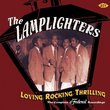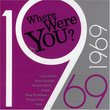| All Artists: Ludwig van Beethoven, Craig Sheppard Title: Beethoven: A Journey [Box Set] Members Wishing: 0 Total Copies: 0 Label: Romeo Records Release Date: 5/31/2005 Album Type: Box set Genre: Classical Styles: Chamber Music, Forms & Genres, Sonatas, Historical Periods, Classical (c.1770-1830), Romantic (c.1820-1910) Number of Discs: 9 SwapaCD Credits: 9 UPC: 675754820725 |
Search - Ludwig van Beethoven, Craig Sheppard :: Beethoven: A Journey [Box Set]
CD DetailsSimilar CDs
|
CD ReviewsAmong the Best Ever Recorded J Scott Morrison | Middlebury VT, USA | 02/26/2006 (5 out of 5 stars) "In contemplating writing a review of this complete live traversal of Beethoven's piano sonatas by Craig Sheppard I've been intimidated by the enormity of the task. And, what's more surprising (particularly if you're familiar with my many other reviews here at Amazon), I've been almost at a loss for words. Not because I don't have anything to say, but because I didn't want my review to sound like it had been bought and paid for by the pianist and his record company. In a word, this is one of the most amazing complete Beethoven sonata traversals I've ever heard. I would, gasp!, rank it right up there with that of Schnabel. Craig Sheppard, a pianist I'd never heard of before, was runner-up to Murray Perahia at the Leeds Piano Competition in 1972; that should tell you how good he is. He has been professor of piano at the University of Washington for some years now and these live performances were recorded there. He played the sonatas in the order in which they were written and he used his own Hamburg Steinway, a fabulous sounding instrument, for the recordings which are, as far as I can tell, unedited. Sound is rich, mellow, full, lifelike. The performances occurred over a period of sixteen months in 2003 and 2004 before live audiences who were extremely quiet except for applause at the end of each sonata. Sheppard has called this set 'Beethoven: A Journey' and that is apt. The composer's style changed amazingly over the years, from relatively simple works in the classical style to far-advanced works that presage what was to come in the decades hence. He is as convincing in the Op. 2 sonatas as he is in the 'Hammerklavier' and the Op. 111. Sheppard manages to adapt his playing to the music at hand. Overall, one could say that his approach is masculine, seemingly unemotional, but in fact deeply emotional. That is, he does not wear his feelings on his sleeve, but there is indeed never an unfelt passage in all thirty-two sonatas. Sheppard has one of the most eloquent left hands I've ever heard (and I've wondered if he is naturally left-handed); it is independent and just as capable as his right in expressing the most amazing shadings of coloration, dynamic and rhythmic subtlety. There are so many felicities, big and little, that it is hard to know where to start. I'll mention only a few. The beginning of the 'Appassionata' is not so much a tiger unleashed but rather a passionate lover pleading his case. The slow movement of the Op. 109 makes time stand still. The final movement of the Op. 31, No. 3 is breathtaking in both its virtuosity (that left hand again!) and its brash high spirits. Well, you get the idea. I kept thinking, as I listened again and again, that if I had the technical ability to play these sonatas I would want to play them like Sheppard. That's about as high a compliment as I can make. And, pssst!, don't tell Amazon, but the set can be obtained from the record label, Roméo [ http://www.romeorecords.com/ ], for about thirty dollars less than the asking price here at Amazon. I would urge you to go for it. Scott Morrison" Highly dramatic, individual Beethoven J Scott Morrison | 05/11/2008 (5 out of 5 stars) "We all find what we want in the Beethoven piano sonatas. It's such a massive set of music, sometimes strictly classical, often introspective, rhythmically playful, sometimes gruffly humorous. And, of course, there are many different ways to approach them: just as the composer wrote them--tempos, phrasing and all; rhetorically--with individual touches of rubato; fussily, with too much intervention by the soloist; or deadened--with a cold approach that sheds no light on the music at all.
Over the years I had narrowed down my choices in these sonatas to two pianists, Artur Schnabel and John O'Conor: Schnabel for his invigorating sense of rhythm and almost stark emotional openness, O'Conor for his stubborn refusal to go outside what Beethoven wrote and his wonderful sense of lyricism. Both sets have strengths and weaknesses. Schnabel is supreme in the early sonatas, in fact better than anyone I've ever heard, living or dead, but he begins to have problems with the middle sonatas, not because of his much-publicized technical flaws but because his view of the music, largely rhythmic in a strict Germanic sense, begins to interfere with the looseness of rhythm and forward-looking treatment of material. O'Conor sometimes underplays the earlier sonatas, and in a few of the middle-period works seems to me too emotionally reserved at times, but from No. 26 onward--excepting the "Hammerklavier"--he is for me supreme above everyone. Now we have a new player in this lofty field, the American pianist Craig Sheppard. His set, too, is to be taken seriously as a major testament to Beethoven's genius. He produces a gorgeous tone and has a sterling technique. His problem is that he is occasionally too slow, at times too rhetorical in phrasing, but when he's good there are none better. Sheppard complains that the first movement of Sonata No. 1 is usually played too fast. My complaint is that he plays it too slowly, and because of this the series gets off to an odd start. Neither Sheppard nor O'Conor play the written sforzandos with much force, which disappoints me: listen to what magic Schnabel makes of them! Conductor Eugen Jochum once told an orchestra that the secret to playing good Beethoven is in his sforzandos, and I agree. O'Conor is better than Sheppard in the second sonata, but in numbers three and four there is no contest. Sheppard is the pianist who rivets your attention while O'Conor is too rigidly metronomic. Sheppard is, by far, the more unbuttoned pianist. He takes more risks, sometimes falling short but often getting the brass ring. He gives one the uncanny feeling that this music is being composed before our very ears. O'Conor, on the other hand, gives the listener a sense of being completely at one with the score. We feel that somehow we're listening to Beethoven himself as he runs through the assembled parts of his now-finished music. Sheppard's greatest failures are an overly-fussy "Moonlight" sonata and too much drama in the last three (more on that later); his greatest triumphs are the best "Pathétique" and "Hammerklavier" I've ever heard. O'Conor, on the other hand, produces a simply magical "Moonlight," "Les Adieux" and No. 16, but a dynamically dead-sounding "Pathétique" and "Appassionata," his greatest failures among the big sonatas. Though O'Conor studied with Wilhelm Kempff, his concept is closer to that of Alfred Brendel. Though Sheppard studied with Claude Frank (a Schnabel pupil) and Rudolf Serkin, his approach is closer to Kempff and Friedrich Gulda. Except for the first two sonatas and the "Moonlight," Sheppard has it all over O'Conor in the first 16 sonatas as well as the early Op. 49 pair. There are a few rhythmic quirks in the "Appassionata," but this is definitely Sheppard's sonata. "Appassionata" is not a word to describe O'Conor's playing and, like the "Pathétique," he fails to generate the proper excitement here. I interviewed O'Conor on the phone during the weekend he recorded the next-to-last disc in the series (Opp. 90-106, which came out splendidly). He told me he had recorded that disc first (the one with "Pathétique" and "Appassionata" on it) and admitted that he was a little hesitant about "cutting loose" on them. I suggested that he consider re-recording them with greater rhythmic accents but, for some reason, he bristled at the suggestion. I wish he had; he missed a golden opportunity to make his set that much better. I was not as comfortable with Sheppard's musical treatment of the last three sonatas. His conception seems, to me, rhythmically flat-footed and too intense, less retrospective than O'Conor. On the other hand, I could hardly wait to hear his "Hammerklavier," and he did not disappoint. The way Sheppard manipulates the dramatic content of this sonata is absolutely heart-stopping; the only performance I've heard to equal it was an old mono recording by Egon Petri. Sheppard is impetuous in his sforzando accents and plays with a more subtle but obvious rubato. His final fugue is simply electrifying; it sounds like a man who has discovered fire. I've been waiting 40 years to hear a performance this good. Likewise, his is the absolute finest "Waldstein" I've heard since Walter Gieseking's legendary 1938 recording for Columbia. You haven't lived until you hear this "Waldstein." Bryce Morrison, a reviewer for Gramophone, said of this set, "This is never Beethoven as we have always known him but sounding as if new-minted, with the dust and patina of stale custom and tradition swept aside with dazzling relish and aplomb." In a sense, true, if one compares Sheppard to most of the pianists who have tackled Beethoven in the past half-century; but we do have Schnabel, and O'Conor was more of a return to ürtext than a stale approach. Reflection is sometimes necessary, our spirits are not always meant to breathe fire, and in Beethoven you had a fusion of both elements. In some ways, O'Conor and Sheppard are a Janus mask, two sides of the same personality. Sheppard now joins him and Schnabel in a very short list of those who have made the most of these magnificent pieces. " |

![Beethoven: A Journey [Box Set]](https://nationalbookswap.com/cd//l/95/5895/6125895.jpg)


